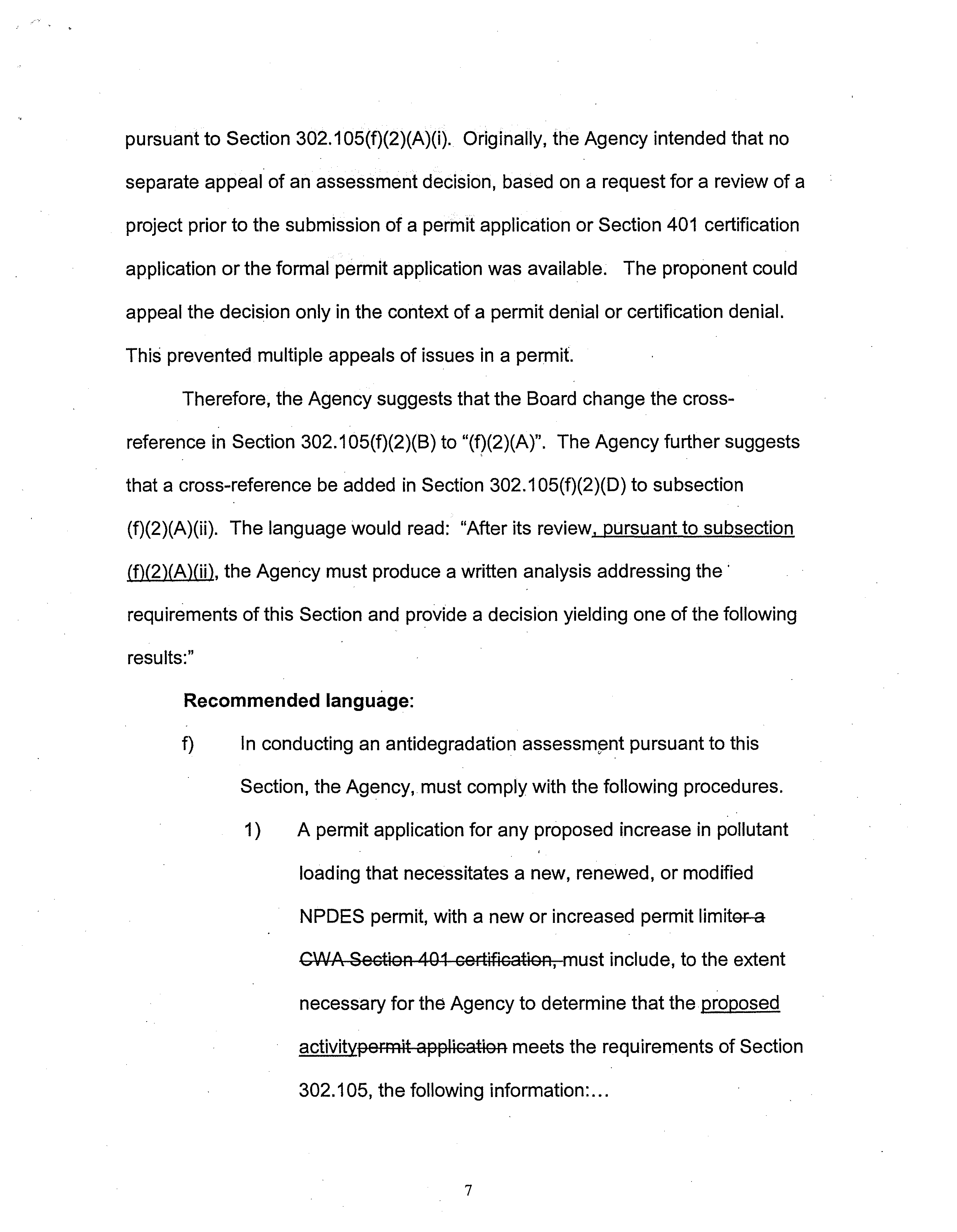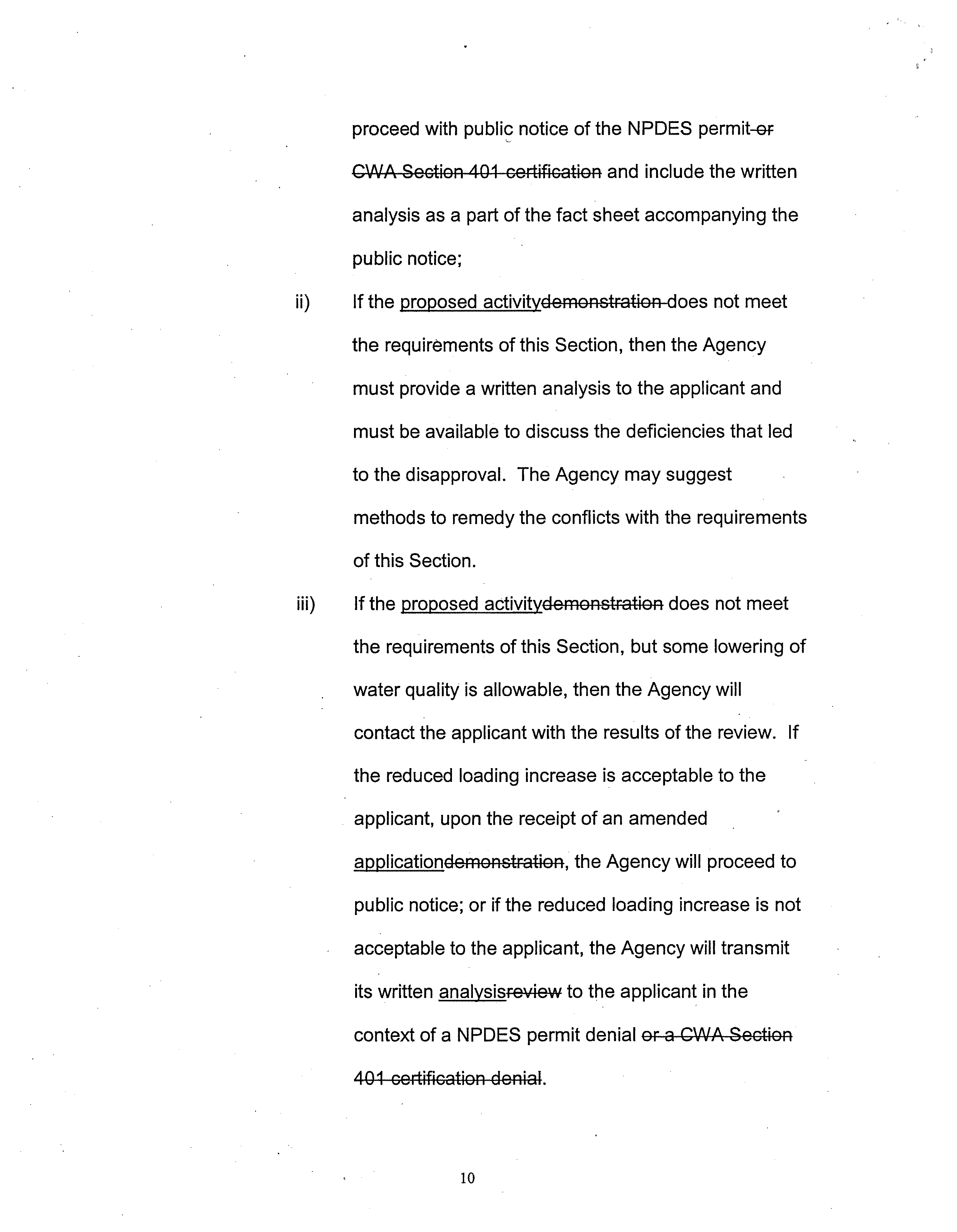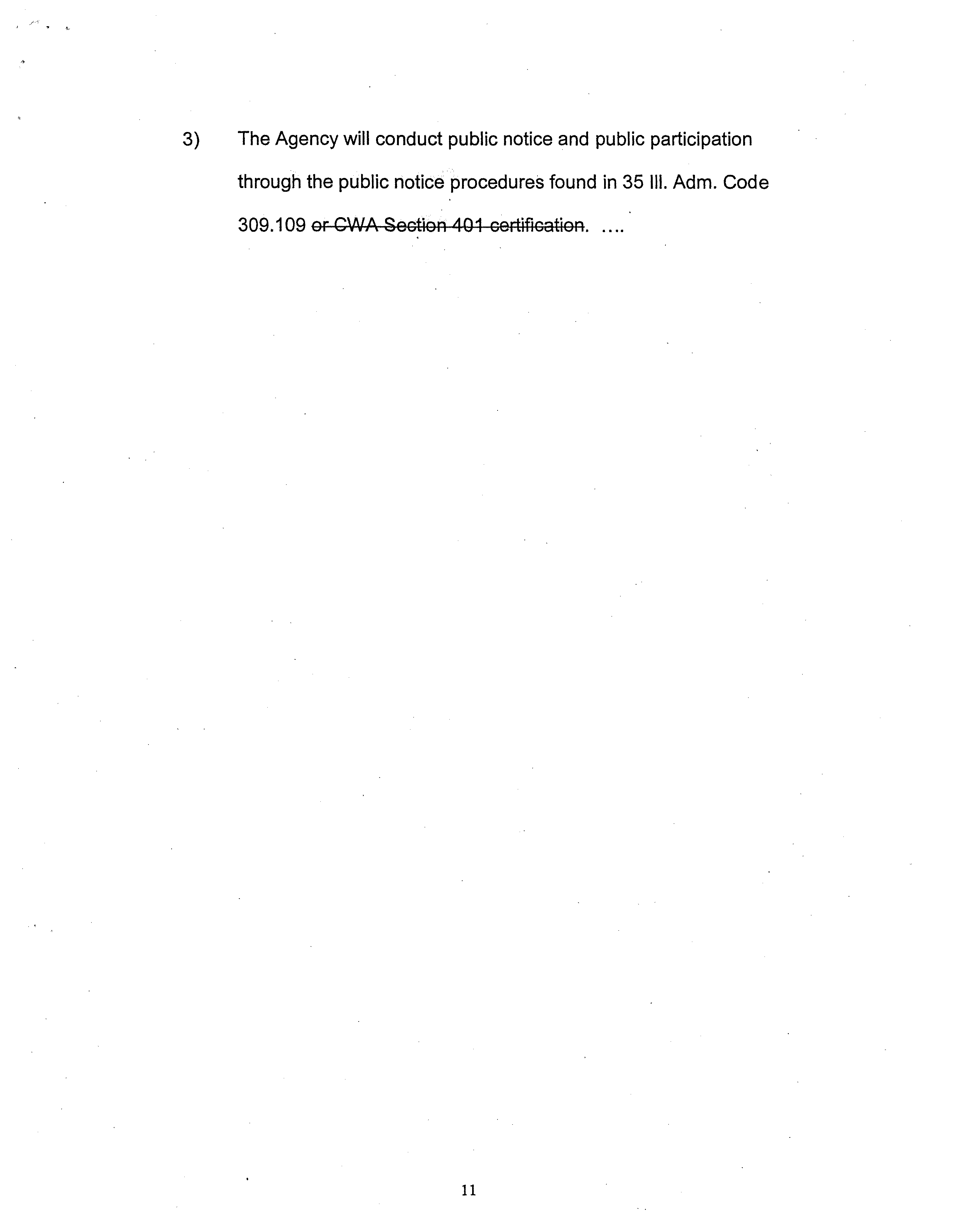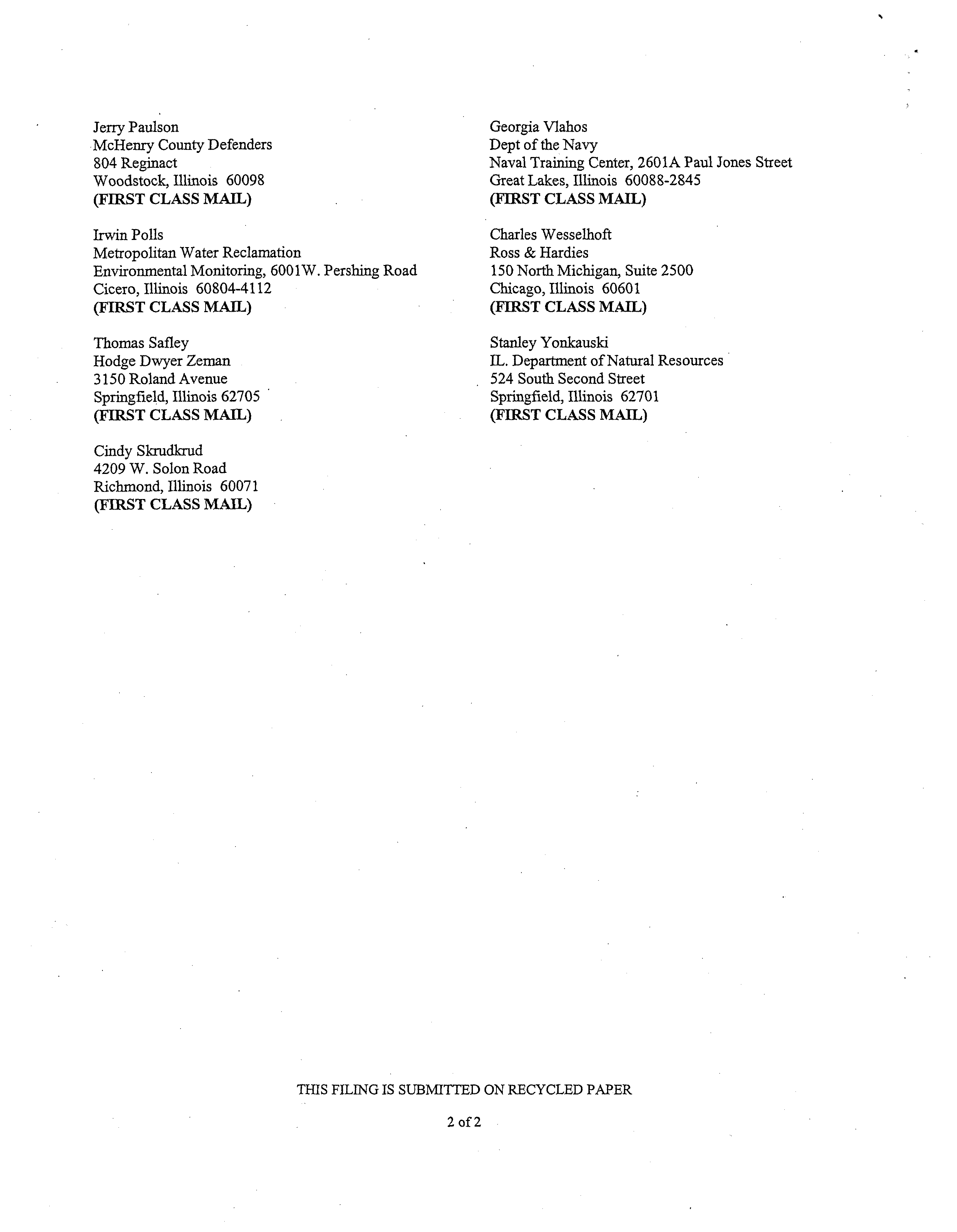RECEIVED
CLERK’S
OFFICE
AUG27
2001
BEFORE THE
STATE
OF ILUNOIS
ILLINOIS
POLLUTION CONTROL BOARD
Pollution
Control Board
INTHEMATTEROF:
)
REVISIONS TO ANTIDEGRADATION
)
R01-13
RULES:
35
ILL. ADM. CODE 302.105,
)
(Rulemaking-Water)
303.205, 303.206,
and102.800-102.830
)
)
COMMENT OF
ILLINOIS ENVIRONMENTAL PROTECTION AGENCY
NOW COMES the ILLINOIS ENVIRONMENTAL PROTECTION AGENCY
(Illinois
EPA),
by
its attorney, Connie
L. Tonsor, and hereby submits comments
in
the above rulemaking.
GENERAL COMMENT
1)
The
Illinois EPA appreciates the Illinois Pollution Control Board’s
(“Board”)
efforts
in this rulemaking
to amend the water quality standard, Section
302.105,
antidegradation.
The
Board’s attention and efforts have facilitated an amended
antidegradation standard that the Illinois EPA believes will continue to assure
protection ofthe waters of the State
of Illinois while recognizing the need for
continued development and utilization ofthe water resources of the State.
As a
result, the Illinois EPA has very few substantive comments or concerns with
regard to Section
302.105 (a) through (e) of the rulemaking.
Although the Illinois EPA did not propose the Part 354 implementation
regulations to be a part of the Board’s water quality standard
but proposed them
as the process that the Illinois
EPA would follow in
interacting with
proposal
applicants, the inclusion of the draft Part 354 agency rules as they relate to the
NPDES permitting process is, as
it testified at hearing, acceptable to the Illinois
EPA.
However, the new subsection 302.105(f)
is applicable to the
permit
process as well
as to the
review of activities requiring a Section 401
of the Clean
WaterAct (“Section
401
“),
33
U.S.C
§
1341, water quality certification prior to
federal
permit issuance.
In contrast to the NPDES permitting
program, the
Illinois EPA is not the delegated
permitting agency for federal permits but must
work with several federal permitting agencies in the Section 401
certification
process.
The Illinois EPA needs to coordinate the procedural aspects of the
antidegradation
review and the
public notice aspects of the review with the
U. S.
Army Corps of Engineers, the Federal
Energy Regulatory Commission, and
Nuclear Regulatory Commission.
The review and coordination with the federal
regulatory processes is not complete.
Therefore,
it
is important that the
implementation procedures for the
Section 401
certification remain Agency rules.
Adoption by the
Board of Section 401
certification procedures as a part of the
water quality standard prior to full coordination with the federal agencies may
cause
conflicts
with the federal process.
The Agency notes that
it
has developed agency procedural
rules for the
Section 401
certification process pursuant to Section 4(m) of the
Act, 415
ILCS
5/4(m), and Section 401(e) of the
CWA,
33
U.S.C.
§
1341.
It will work toward the
adoption
of antidegradation
assessment rules as part of the revision of Part 395.
2)
Many of the proposed agency regulations,
now Section 302.105(f)
address day-to-day communication between the
permit applicant and the Illinois
2
EPA.
The substantive requirements of the antidegradation water quality
standard are contained
within Section 302.105
(a) through
(e) of the
first notice
document.
Several of the aspects of the day-to-day operation, such as how
the
Illinois EPA will respond to informal
inquiries, seem inappropriate to be
contained within the water quality standard for the State.
These are the
operational aspects reaching a decision with regard to a
permit.
The
Illinois
EPA would suggest that the
communicational aspects not be
a part of the
Board’s regulations.
Additionally, the
Illinois EPA, with regard to the
National
Pollutant Discharge Elimination System
(“NPDES”) portion of Section
302.105(f), urges the
Board to place the
permitting procedures
in 35
Ill. Adm.
Code 309., which addresses procedures for permit issuance.
SPECIFIC COMMENTS
1)
Section 302.1 05(b)(4)
The new subsection reference
“must be assessed pursuant to subsection (f)”is~
applicable to the
permit process as well as to the review of activities requiring a
Section 401, water quality certification prior to federal permit issuance.
The
Illinois EPA must work with several federal agencies
in the Section
401
certification process.
The Illinois EPA needs to coordinate the procedural
aspects of the antidegradation
review with those agencies.
Therefore,
it is
important that the implementation process ofthe
Section
401
of review remain
Agency rules.
The Agency notes that his has developed agency procedural rules
for the
Section 401
certification process pursuant to Section 4(m) of the
Act, 415
3
ILCS 5/4(m), and Section 401(e) of the CWA,
33
U.S.C.
§1341 for the CWA
certification.
Recommended
language:
4)
“Any proposed increase in pollutant loading
requiring an
NPDES permit or a
CWA 401
certification for an ORW must
be assessed pursuant to a subsection
(f) to determine
compliance with this Section.
5)
“Any activity reguiring a CWA Section
401
certification for an
ORW must be assessed during the
Section 401
certification
process to determine compliance with this section.”
2)
Section 302.105(d)(6)
The Section 401
certification process does not use the phrase “general”
Section
401
certification.
In order to eliminate
any potential
confusion, the
Illinois EPA suggests that the term “general” be replaced with the phrase:
“for
nationwide or regional Section 404
permits.”
Recommended
language:
“Discharges permitted under a current general NPDES permit as
provided by 415 ILCS 5/39(b) or a general
CWA, Section 401
certification
for nationwide or regional Section 404 permits are not subject to facility-
specific antidegradation
review; however, the Agency must assure that
individual permits or certifications are
required prior to
all new pollutant
loadings or hydrological modifications that necessitate a new, renewed or
4
modified NPDES permit or CWA,
Section 401
certification that affect
waters of particular biological significance; or”
3)
Section 302.105(f)
The Illinois EPA has three overall comments with regard to Section
302.105(f).
A)
The
Illinois EPA strongly urges the
Board to delete references to
the
Section 401
certification process from the new Section
302.105(f) for the
reasons stated
in the testimony of Toby Frevert and incorporated into this
comment by reference
and for the reasons stated
in the General Comments.
B)
The
Illinois EPA
is currently reviewing the language of first notice
302.105(f) for the purpose
of streamlining the language and
placing the
portions
that concern the substantive review process into 35
III. Adm.
Code 309.
The
Illinois EPA has not yet completed this process but will have language available
at the hearing in this matter.
Preliminarily, the
Illinois EPA believes that the
communicational aspects of Section
302.105(f), 302.1 05(f)(2)(A) and
(C), should
be removed from
Board regulations.
Therefore, the Board
regulations would
address reviews that are a part of the
formal permit process.
However, the
Illinois EPA notes that a
lack of clarity in the language
may
have occurred in the draft implementation rules, which are
now Section
302.105(f) of the water quality standard,
It offers language corrections to
address the
lack of clarity in this comment.
The “demonstration
review” language
developed when the proponent of the activity was required to provide information
that demonstrated that its proposal would meet the requirements of the Section
5
302.105.
During the
rulemaking process and hearing process, the
Illinois EPA
generally agreed that the “demonstration by the proponent” concept should
be
replaced with an “assessment of the proposed
activity”
by the
Illinois EPA
concept.
The Part 354
language was not changed to reflect this agreement, and
the language in Section
302.105(f) should be
modified to reflect this change.
C)
During the formulation of the antidegradation regulations, concerns
arose that the Agency not create a
situation
in which several appeals of parts of
a
permit decision or certification decision could
occur.
However, the workgroup
and the Agency agreed that a need existed for the Agency to review projects
in a
preliminary stage and prior to the filing of an application.
This would facilitate
planning for the
regulated
community.
The Agency made a commitment to the
regulated
community to conduct this
preliminary review.
Therefore,
in the Proposed Part 354 rules, the Agency set out a two-tiered
review and stated that
it would initiate the
review process based on
an
informal
inquiry.
However, the Agency emphasized that no appeal of the decision
on
a
preliminary
inquiry could
occur outside of the permit denial or certification
process and the formality of its response would depend upon the
formality of the
inquiry.
This two-tiered process has become
mingled in Section
302.105(f)(2)(B).
Currently,
Section 302.105(f)(2)(B), the cross-reference is to subsection
(f)(2)(A)(i).
Therefore, no
immediate appeal
is available ofthe decision after
receipt of an
application.
However, an immediate appeal arguably could
be
brought afterthe
Agency’s assessment of an informal or preliminary inquiry
6
pursuant to Section 302.105(f)(2)(A)(i).
Originally, the Agency intended that
no
separate appeal of an assessment decision,
based on a request for a
review of a
project prior to the submission of a permit application or Section
401
certification
application or the formal permit application was avaiIable~ The proponent could
appeal the decision only in the context of a permit denial or certification denial.
This prevented
multiple appeals of issues in a
permit.
Therefore, the Agency suggests that the
Board change the cross-
reference in Section
302.105(f)(2)(B) to “(f)(2)(A)”.
The Agency further suggests
that a cross-reference be added
in Section 302.1 05(f)(2)(D) to subsection
(f)(2)(A)(ii).
The language would
read:
“After its
review,
pursuant to subsection
(f)(2)(A)(ii), the Agency must produce
a written analysis addressing the
requirements ofthis Section
and
provide a decision yielding one of the following
results:”
Recommended
language:
f)
In conducting an antidegradation assessmpnt pursuant to this
Section, the Agency,
must comply with the following procedures.
1)
A permit application for any proposed increase in pollutant
loading that necessitates a new, renewed, or modified
NPDES permit, with a new or increased permit limitof-a
CWA Section
‘101
certification, must include, to the extent
necessary for the Agency to determine that the proposed
activitypermit application meets the requirements of Section
302.105, the following
information:...
7
D)
Assessments of alternatives to proposed increases
in
pollutant loading or activities subject to Agency
certification pursuant to Section
401
of the
CWA that
result in less of a load increase,
no load increase or
minimal environmental degradation. Such
alternatives
include...
2)
The Agency must complete an antidegradation assessment
demonstration
review in accordance with the provisions
of this
Section.
A)
The antidegradation
assessment pursuant to this Section
is
a part of the
NPDES permitting process or the
CWA Section
401
certification process.
However, applicants may initiate
communication with the Agency,
preferably during the
planning stage for any load
increase.
Communication will
help assure the adequacy of information
necessary to
complete anconstitute an antidegradation
assessmentdemonctration and
avoid or minimize delays and
requests for supplemental information
during the
permitting
stage.
The Agency assessmentreviewprocess must be
initiated by:
I).
8
ii)
receipt of application for an
NPDES permit issuance,
renewal or modification or a
CWA Section
401
certification.
B)
A proponent seeking an immediate review of the results of
the
Agency’s assessmentreviewpursuant to subsection
(f)(2)(A) must do so within the
NPDES permit process or the
CWA Section 101
certification process.
C)
After an_assessmentreviewpursuantto subsection (f)(2)(A)(i),
the Agency must consult with the proponent and respond:
i)
in writing to written requests.
The written
response
will
include a statement by the Agency indicating
whether the proposed activitydernonstration, based
upon
the
information provided or information
acquired
by the Agency during the
review process, meets the
criteria of this Section.
ii)....
iii).
D)
After its assessment pursuant to subsection
IflflDceviev,
the Agency must produce a written
analysis addressing the requirements of this Section and
provide a decision yielding one of the following results.
i)
If the proposed activitydemonstration
meets the
requirements of this Section, then the Agency must
9
proceed
with public notice of the
NPDES permit-ef
CWA Section 401
certification and
include the written
analysis as a part of the fact sheet accompanying the
public notice;
ii)
If the
proposed activitydemonstration does not meet
the requirements of this Section, then the Agency
must provide a written analysis to the applicant and
must be available to discuss the deficiencies that led
to the disapproval.
The Agency may suggest
methods to remedy the
conflicts with the requirements
of this Section.
iii)
If the proposed activitydemonstration does not meet
the requirements of this Section,
but some lowering of
water quality
is allowable, then the Agency will
contact the applicant with the results of the
review.
If
the reduced
loading increase is acceptable to the
applicant,
upon the receipt of an amended
applicationdemonstration, the Agency will proceed to
public notice; or ifthe reduced loading increase is
not
acceptable to the applicant, the Agency will transmit
its written analysisreview to the applicant in the
context of a
NPDES permit denial or a CWA Section
401
certification
denial.
10
3)
The Agency will conduct
public notice and
public participation
through the
public notice procedures found
in 35
Ill. Adm. Code
309.109 or CWA Section
401
certification
11
Respecifully submitted,
August
10,
2001
Illinois Environmental Protection Agency
1021
North Grand Ave. East
P.O. Box 19276
Springfield,
Illinois 62794-9276
ILLINOIS
ENVIRONMENTAL
PROTECTION AGENCY
By:
..
~
Connie
L. Tonsor
12
STATE OF ILLINOIS
COUNTY OF SANGAMON
)
)
)
SS
)
)
PROOF OF SERVICE
I, the undersigned, on oath state that I have served the attached TESTIMONY
OF TOBY FIREVERT AN)
COMMENT
OF
THE ILLINOIS ENVIRONMENTAL PROTECTION
AGENCY
upon the personto whom
it
is directed, by placing a copy in an envelope addressed to:
Dorothy M. Gunn, Clerk
Illinois PollutionControl Board
James R. Thompson Center
100 West Randolph Street, Suite 11-500
ChicagO, Illinois
60601.
(FIRST
CLASS
MAIL)
Marie E. Tipsord
Hearing Officer
Illinois Pollution control Board
100 West Randolph St.
Suite 11-500
Chicago, Illinois
60601
(FIRST CLASS MAIL)
AND THE ATTACHED SERVICELIST
(FIRST
CLASS MAIL)
and mailing it from Springfield, Illinois on
_________
,
200 iwith sufficientpostage affixed as indicated above.
F
IAL
SEAt
RICHARD C.WARRINGTON
Notary
Pub’ic, State of Illinois
My CommissIon Expires O2~18-2Qg4
SUBSCRIBED
thi~/Q.
day
TIllS FILING
IS
SUBMITTED ON RECYCLED PAPER
Service
List
August
10, 2001
Dorothy Gunn
Clerk, PollutionControl Board
100 West Randolph, Suite 11-500
Chicago, Illinois
60601
(FIRST
CLASS
MAIL)
Marie Tipsord
Attorney, Pollution Control Board
100
West Randolph,
Suite 11-500
Chicago, Illinois
60601
(FIRST CLASS MAIL)
Kay Anderson
American Bottoms RWTF
One American Bottoms Road
Sauget, Illinois
62201
(FIRST
CLASS
MAlL)
Fredric P. Andes
Barnes &Thornburg
2600 Chase Plaza,
10
S. LaSalle Street
Chicago, Illinois
60603
(FIRST
CLASS
MAIL)
Karen L. Bernoteit
IL Environmental Regulatory Group
215 E. Adams
St.
Springfield, illinois
62701-1199
(FIRST CLASS MAIL)
Chris Bianco
Chemical Industry Council
9801
W. Higgins Road,
Suite
515
Rosemont, Illinois
60018
(FIRST CLASS MAIL)
Christine Bucko
AAG
188 W. Randolph, 20th Floor
Chicago, Illinois
60601
(FIRST
CLASS
MAIL)
JackDarin
Sierra Club, Illinois Chapter
200 N. Michigan, Suite
505
Chicago, Illinois
60601
(FIRST CLASS rt~j~4JI~4.
Albert Ettinger
Environmental Law &Policy Center
35
E. Wacker Drive, Suite 1300
Chicago, Illinois
60601-2110
(FIRST CLASS MAIL)
Susan M. Franzetti
Sonnenschein Nath & Rosenthal
8000
Sears Tower, 233
South Wacker Drive
Chicago, Illinois
60606
(FIRST
CLASS
MAIL)
James T. Harrington
Ross & Hardies
150 North Michigan, Suite 2500
Chicago, Illinois
60601
(FIRST
CLASS MAIL)
JohnM. Heyde
Sidley & Austin
Bank One Plaza,
10 So.
Dearborn St.
Chicago, Illinois
60603
(FIRST
CLASS
MAIL)
Katherine Hodge
Hodge &Dwyer
3150 RolandAve., P0 Box 5776
Springfield, Illinois
62705-5776
(FIRST
CLASS MAIL)
Richard I. Kissel
Gardner, Carton & Douglas
321
N. Clark Street, Suite 3400
Chicago, Illinois
60610
(FIRST CLASS MAlL)
Robert Messina
Illinois Environmental Regulatory Group
215 East Adams Street
Springfield, Illinois
62701
(FIRST CLASS MAIL)
Sharon Neal
ComEd
-
Unicom
LawDept.
125
S.
Clark St.
Chicago, Illinois
60603
(FIRST
CLASS
MAIL)
THIS FILING IS SUBMITFED ON RECYCLED PAPER
1
of 2
JerryPaulson
McHenry County Defenders
804
Reginact
Woodstock, Illinois
60098
(FIRST CLASS MAIL)
Irwin Polls
Metropolitan Water Reclamation
Environmental Monitoring,
600 1W. Pershing Road
Cicero, Illinois
60804-4112
(FIRST
CLASS MAIL)
Thomas
Safley
Hodge Dwyer Zeman
3150 Roland Avenue
Springfield, Illinois 62705
(FIRST
CLASS MAIL)
Cindy Skrudkrud
4209 W. Solon Road
Richmond,
Illinois
60071
(FIRST
CLASS
MAIL)
Georgia
Viahos
Dept of the Navy
NavalTraining Center, 2601A Paul Jones Street
Great Lakes, Illinois
60088-2845
(FIRST
CLASS MAIL)
Charles Wesseihofi
Ross &Hardies
150 North Michigan, Suite 2500
Chicago, Illinois
60601
(FIRST
CLASS
MAIL)
Stanley Yonkauski
IL. Department of NaturalResources
524
South Second Street
Springfield, Illinois
62701
(FIRST
CLASS MAIL)
THIS FILINGIS SUBMITTED ON RECYCLED PAPER
2 of 2
















